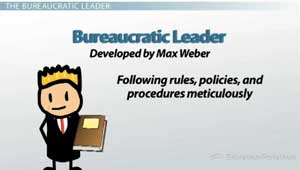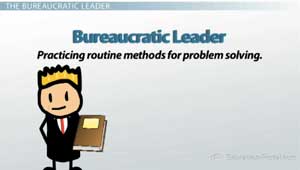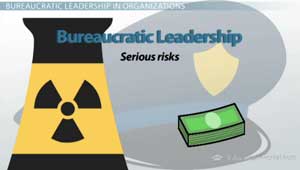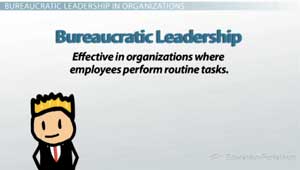The Bureaucratic Leader - Quiz
Choose your answer and write the correct one down. Then click HERE for the answers to this quiz.
NOTE: The transcript from the video is listed below the quiz for your reference.
1. Which of these situations will Bureaucratic leadership fail?
- when an organization needs to promote change and take risks on a regular basis
- when an organization is stable
- when an organization leads its competitors in sales
- when an organization is team-based
- when there is a diverse workforce
2. Which of these situations are useful to use a Bureaucratic leadership style?
- when there are serious risks and also when employees perform routine tasks.
- when there are minimal risks and when employees perform routine tasks.
- when there are minimal risks but employees must adapt to new job responsibilities on a daily basis
- when there are serious risks but employees must adapt to new job responsibilities on a daily basis
- when there are moderate risks and when employees perform routine tasks.
3. The following are characteristics of bureaucratic leadership, except:
- meticulous adherence to rules, policies, and procedures
- decisions are typically slow paced
- practices routine methods for problem solving
- is change savvy and looks for ways to inspire innovation
- following rules by-the-book
4. Bureaucratic leadership follows a <b></b><b></b><b>_ management philosophy</b>
- 'by the seat of their pants'
- 'it depends'
- 'by the book'
- 'just-in-time'
- 'whatever it takes'
5. This person is considered to have developed the idea of bureaucratic leadership.
- Max Weber
- Chester Bernard
- Elton Mayo
- Charles Newton
You may hear people complain about the bureaucratic system and how it processes things slowly, but do you know why? This lesson describes characteristics of the bureaucratic leader. Learn how bureaucratic leadership can be used to improve businesses.
Note: For the purposes of this video, the instructor is using the American pronunciation of Max Weber's name.
By The Book
There are certain times that you expect someone to do things 'by the book.' For example, you want to make sure that your parachute is packed 'by the book' before you head out to sky dive. Likewise, you want your tattoo artist to follow your drawing 'by the book.' You might also expect your repairman to fix your problem 'by the book.'
 |
The Bureaucratic Leader
Someone who follows a 'by the book' management philosophy is referred to as a bureaucratic leader, a style that was first developed by Max Weber in 1947. Following rules, policies and procedures meticulously is what the bureaucratic leader lives for.
 |
 |
Bureaucratic leaders expect their employees to follow the normative regulations they impose because of their formal role in the organization and the authority bestowed onto them. The employees who conform to the bureaucratic leader are often rewarded.
Bureaucratic Leadership in Organizations
Bureaucratic leadership is useful in organizations where there are serious risks, such as what you would expect at a nuclear power plant, a police station, a bank or other financial institution that deals with large amounts of money; or when working with dangerous machinery.
 |
 |
Whether safety or efficiency is the focus, bureaucratic leaders provide an apparent and strict leadership style that works to maintain the highest level of compliance in these types of organizations. Where bureaucratic leadership can fail is in organizations that must adapt to change and take risks on a regular basis. Some believe that bureaucratic leaders can stifle creativity, innovation and flexibility in organizations, preventing the company from reaching its goals.
To help you better understand bureaucratic leadership, let's take a look at this example. Bob is the head of a manufacturing company called Bikes for Tykes. He decided early on that quality, efficiency and safety were at the top of his priorities. To ensure that his employees were on the same page, Bob adopted a bureaucratic leadership style. Bob believes Bikes for Tykes is the perfect place for bureaucratic leadership due to the important safety issues surrounding the assembly of bikes - especially bikes that will be used by children - as well as the routine nature of assembling the bikes.
As a bureaucratic leader, Bob provides each employee with a standard procedure for how to perform their task in the bike assembly process. Since the bikes are put together piece by piece as it moves down the assembly line, Bob can be confident that by providing each individual station with precise directions on how to complete their task, each bike will be completed with a high level of quality and efficiency. If Bob notices any deviation in the standards that he put into place, he will take corrective actions to bring the process back to where it needs to be. Those employees who consistently uphold the standard are rewarded.
Lesson Summary
Let's review. Bureaucratic leadership was first described by Max Weber in 1947. Following rules, policies and procedures meticulously is the most defining characteristic of the bureaucratic leader. Decisions are typically slow paced and they ensure adherence to the principles of the organization by practicing routine methods for problem solving.
Bureaucratic leaders expect their employees to follow the normative regulations they impose because of their formal role in the organization and the authority bestowed onto them. Those employees who conform to the bureaucratic leader are often rewarded. Bureaucratic leadership is useful in organizations where there are serious risks and also when employees perform routine tasks. Where bureaucratic leadership can fail is in organizations that must adapt to change and take risks on a regular basis. Some believe that bureaucratic leaders can stifle creativity, innovation and flexibility in organizations, preventing the company from reaching its goals. As with all leadership styles, it is up to the leader to adopt the style that is most fitting for the organization in which he or she operates.